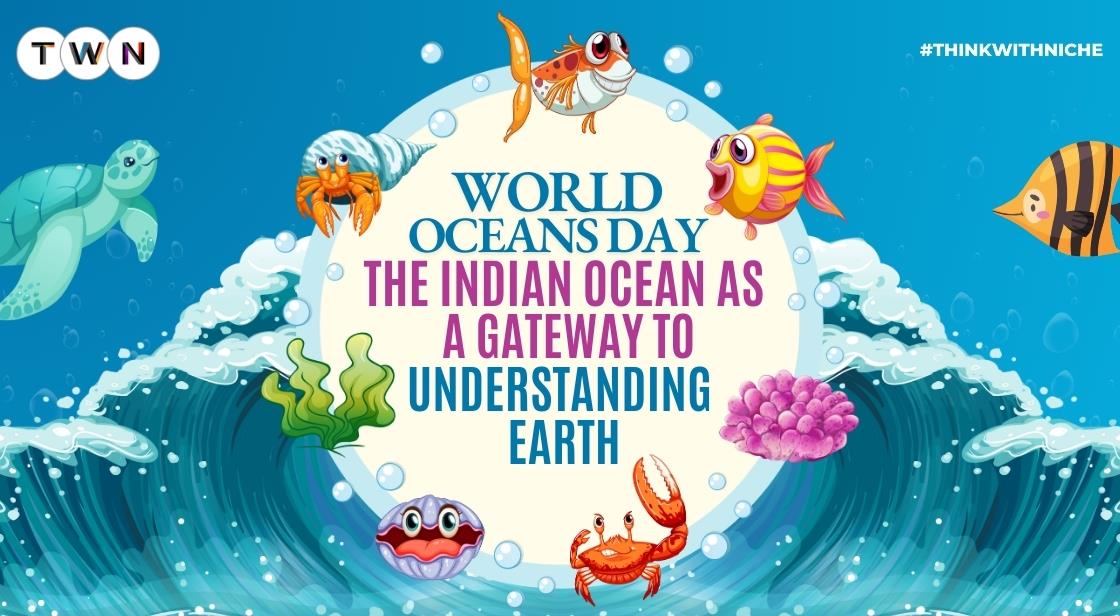World Oceans Day 2024: The Indian Ocean as a Gateway to Understanding Earth

Blog Post
World Oceans Day serves as a poignant reminder of the critical role oceans play in shaping our planet's ecological balance and overall well-being. As we commemorate this global observance, we turn our focus towards the majestic Indian Ocean, a vast body of water whose significance transcends its geographical boundaries.
The urgency for understanding our oceans has never been greater. The United Nations Climate Change reports that the ocean, as the planet's greatest carbon sink, has absorbed a staggering 90 percent of the heat generated by rising greenhouse gas emissions. This immense burden comes at a cost, fundamentally altering ocean ecosystems and triggering a cascade of environmental consequences.
The Indian Ocean, however, offers a unique opportunity. Beyond its shimmering surface lies a gateway to unlocking profound insights into the intricate workings of Earth's natural systems. By studying its rapid warming, unique oceanic configurations, and the environmental consequences it faces, we gain a deeper understanding of our planet's response to climate change and human activity.
This World Oceans Day, we celebrate the Indian Ocean as more than just a vast expanse of water. It is a window into understanding the broader complexities of our planet. Join us as we embark on a journey to explore the Indian Ocean's role as a gateway to understanding Earth, recognizing its significance not only today, but every day in our collective efforts towards environmental stewardship and sustainability.
Join us as we embark on a journey to explore the Indian Ocean's role as a gateway to understanding Earth, recognizing its significance not only on World Oceans Day but every day in our collective efforts towards environmental stewardship and sustainability.
"We know only too well that what we are doing is nothing more than a drop in the ocean. But if the drop were not there, the ocean would be missing something." Mother Teresa
World Oceans Day 2024: Understanding the Indian Ocean to Unlock Earth's Secrets
1. History and Purpose of World Oceans Day:
Establishment of World Oceans Day by the United Nations
In 2008, the United Nations officially designated June 8th as World Oceans Day to raise global awareness about the importance of oceans and promote the sustainable management and conservation of marine resources.
This decision stemmed from the recognition of the critical role that oceans play in supporting life on Earth and the need for concerted efforts to address the various threats facing marine environments.
Goals and Objectives of World Oceans Day:
The primary goals of World Oceans Day are to highlight the significance of oceans in maintaining planetary health and to mobilize action towards their protection and conservation. By fostering a deeper understanding of ocean ecosystems and their interconnectedness with human well-being, World Oceans Day aims to inspire individuals, communities, and governments to take proactive measures to safeguard marine environments.
Raising Awareness about Oceans Importance:
One of the key purposes of World Oceans Day is to raise awareness about the critical role that oceans play in sustaining life on Earth. Through educational initiatives, public outreach campaigns, and community events, World Oceans Day seeks to inform people about the myriad benefits provided by oceans, including climate regulation, food security, biodiversity, and recreational opportunities.
Promoting Action to Protect Marine Environments:
Another vital objective of World Oceans Day is to catalyze action to address the various threats facing marine environments. By highlighting pressing issues such as pollution, overfishing, habitat destruction, and climate change, World Oceans Day seeks to galvanize individuals and organizations to adopt sustainable practices and policies that promote ocean conservation and stewardship.
Global Collaboration and Engagement:
World Oceans Day serves as a platform for fostering global collaboration and engagement in addressing ocean-related challenges. Through partnerships between governments, civil society organizations, businesses, and academia, World Oceans Day facilitates dialogue, knowledge-sharing, and collective action towards achieving ocean sustainability goals outlined in international agreements such as the United Nations Sustainable Development Goals (SDGs).
2. Theme of World Oceans Day 2024:
Introduction to the Theme of World Oceans Day 2024:
World Oceans Day 2024 adopts the theme "Ocean Solutions for Climate Action" to spotlight the critical role oceans play in combating climate change. This theme underscores the urgent need to harness the potential of oceans as a source of solutions to mitigate the impacts of global warming and environmental degradation.
Emphasizing the Role of Oceans in Climate Mitigation:
The theme highlights the significance of oceans as natural carbon sinks, absorbing a substantial portion of the planet's carbon dioxide emissions. Oceans act as crucial regulators of the Earth's climate system, playing a vital role in regulating temperatures and weather patterns.
Addressing Environmental Challenges:
By focusing on "Ocean Solutions for Climate Action," the theme underscores the interconnectedness of ocean health and environmental sustainability. It emphasizes the need for collaborative efforts to address pressing environmental challenges such as ocean acidification, sea level rise, and loss of marine biodiversity.
Promoting Collaborative Efforts:
The theme emphasizes the importance of collaborative initiatives involving governments, policymakers, scientists, industries, and civil society to implement effective solutions. It calls for collective action to protect and restore marine ecosystems, reduce carbon emissions, and promote sustainable ocean management practices.
Harnessing Oceanic Potential:
World Oceans Day 2024 encourages exploring innovative solutions and technologies that harness the potential of oceans to mitigate climate change. This includes leveraging ocean-based renewable energy sources such as offshore wind, tidal, and wave energy, as well as sustainable ocean farming and carbon capture and storage initiatives.
Mobilizing Global Awareness:
Through the theme "Ocean Solutions for Climate Action," World Oceans Day 2024 aims to raise awareness about the critical link between ocean health and climate resilience. It seeks to mobilize global support and advocacy for policies and actions that prioritize ocean conservation and sustainability in the face of climate change.
Inspiring Action and Engagement:
The theme serves as a call to action for individuals, communities, and stakeholders worldwide to take concrete steps towards ocean conservation and climate mitigation. It encourages active participation in ocean-related initiatives, beach clean-ups, educational programs, and advocacy campaigns to protect our planet's blue heart.
Also Read: International Day for Biological Diversity 2024: Best Conservation Efforts and Success Stories
3. Significance of Celebrating World Oceans Day:
World Oceans Day serves as a vital platform for raising awareness about the critical importance of oceans to our planet's health and well-being. By designating a specific day to honor and celebrate oceans, we acknowledge their immense significance and the urgent need to protect and conserve them for future generations.
Inspiring Advocacy and Education:
One of the key roles of World Oceans Day is to inspire advocacy and education on marine conservation issues. Through a variety of events, activities, and educational initiatives, people worldwide are encouraged to learn about the challenges facing oceans and the actions they can take to address them. This fosters a sense of responsibility and empowerment among individuals and communities to advocate for policies and practices that promote ocean health.
Mobilizing Action for Conservation Initiatives:
World Oceans Day plays a crucial role in mobilizing action for conservation initiatives on both local and global scales. By raising awareness of pressing issues such as plastic pollution, overfishing, and habitat destruction, the day encourages individuals, organizations, and governments to take concrete steps towards protecting oceans and marine life. This can include participating in beach clean-ups, supporting marine protected areas, and advocating for sustainable fishing practices.
Fostering Global Awareness:
Celebrating World Oceans Day fosters global awareness of the interconnectedness of oceans with all life on Earth. Through social media campaigns, educational programs, and public events, people from diverse backgrounds come together to learn about the importance of oceans and the role they play in sustaining life. This heightened awareness promotes a sense of stewardship and encourages individuals to make informed choices that benefit ocean conservation efforts.
Promoting Collaboration and Partnerships:
World Oceans Day provides a platform for promoting collaboration and partnerships among governments, NGOs, businesses, and communities to address ocean conservation challenges.
By bringing together stakeholders from different sectors, the day facilitates the exchange of ideas, resources, and expertise to develop innovative solutions for protecting and preserving oceans and marine ecosystems.
This collaborative approach enhances the effectiveness and impact of conservation efforts, leading to positive outcomes for oceans and the planet as a whole.
4. Activities and Events on World Oceans Day:
World Oceans Day serves as a platform for organizing a diverse range of activities and events globally to raise awareness about the importance of ocean conservation and sustainability.
Beach Clean-Ups: Beach clean-ups are a common activity organized on World Oceans Day, where volunteers gather to remove litter and debris from shorelines and coastal areas. These clean-up efforts not only help improve the aesthetic appeal of beaches but also prevent marine debris from harming marine life.
Educational Workshops: Educational workshops are conducted on World Oceans Day to provide participants with knowledge about marine ecosystems, biodiversity, and conservation efforts. These workshops may cover topics such as plastic pollution, coral reef preservation, and sustainable fishing practices, aiming to empower individuals with information to make informed choices and take action for ocean conservation.
Film Screenings: Film screenings featuring documentaries and films focused on ocean conservation and marine biodiversity are organized as part of World Oceans Day events. These screenings provide audiences with insights into the challenges facing oceans and inspire them to become advocates for marine conservation through visual storytelling and impactful narratives.
Community Outreach Programs: Community outreach programs aim to engage local communities in ocean conservation efforts by organizing interactive activities and initiatives. These programs may include interactive exhibits, art competitions, and coastal clean-up drives, fostering a sense of collective responsibility and promoting stewardship of marine resources within communities.
Citizen Science Projects: Citizen science projects encourage public participation in data collection and monitoring activities related to marine ecosystems. Participants may contribute to initiatives such as wildlife surveys, water quality monitoring, and coral reef assessments, providing valuable data for scientific research and conservation efforts.
5. Achievements and Challenges in Oceans Conservation:
Progress in Ocean Conservation Efforts:
Highlighting achievements in ocean conservation, such as the establishment of Marine protected areas (MPAs) worldwide.
Providing examples of successful MPAs, such as the Papahānaumokuākea Marine National Monument in Hawaii, which covers over 1.5 million square kilometers and preserves a diverse range of marine species and habitats.
Reduction of Plastic Pollution:
Examining successful initiatives aimed at reducing plastic pollution in oceans, including bans on single-use plastics and campaigns promoting plastic recycling.
Example: The European Union's ban on single-use plastics, which aims to reduce marine litter and protect ocean ecosystems from the harmful effects of plastic pollution.
Ongoing Challenges in Ocean Conservation:
Identifying persistent challenges that continue to threaten ocean health, such as overfishing, habitat destruction, and ocean acidification.
Discussing the impact of overfishing on marine biodiversity and ecosystem balance, as well as the role of unsustainable fishing practices in depleting fish stocks.
Habitat Destruction:
Exploring the ongoing destruction of critical marine habitats, including coral reefs, mangroves, and seagrass beds, due to factors such as coastal development and climate change.
Example: The degradation of coral reefs in the Great Barrier Reef due to coral bleaching caused by rising ocean temperatures.
Ocean Acidification:
Discussing the phenomenon of ocean acidification, which is driven by the absorption of carbon dioxide by seawater, resulting in lower pH levels and adverse effects on marine life.
Example: The impact of ocean acidification on shell-forming organisms such as oysters and corals, which struggle to build and maintain their calcium carbonate structures in acidic
6. Rapid Warming of the Indian Oceans:
The Indian Ocean has garnered recent attention due to its alarming rate of warming, which surpasses that of other major oceans. Scientific studies have documented a significant increase in sea surface temperatures across the Indian Ocean basin, with some regions experiencing unprecedented warming trends.
This rapid warming poses serious implications for marine ecosystems, weather patterns, and coastal communities dependent on ocean resources for livelihoods.
Outsized Influence on Global Climate Dynamics:
Despite being the smallest of the world's major oceans, the Indian Ocean exerts a disproportionate influence on global climate dynamics. Its unique geographical position and oceanic features contribute to its remarkable impact on weather patterns, ocean currents, and atmospheric circulation systems.
The Indian Ocean's warming trends have far-reaching consequences, affecting climate variability across continents and influencing regional climates in adjacent landmasses.
Shaping the Earth's Oceanic Response to Climate Change:
The Indian Ocean plays a pivotal role in shaping the Earth's overall oceanic response to climate change. As one of the primary heat reservoirs in the global ocean system, its warming trends contribute significantly to the redistribution of heat and energy within the oceans.
This, in turn, influences ocean circulation patterns, sea level rise, and marine biodiversity. Understanding the Indian Ocean's response to climate change is essential for predicting and mitigating the impacts of global warming on marine ecosystems and coastal communities worldwide.
Addressing the Challenges:
Efforts to address the rapid warming of the Indian Ocean require coordinated action at local, regional, and international levels. Implementing measures to reduce greenhouse gas emissions, promoting sustainable ocean management practices, and enhancing scientific research and monitoring efforts are crucial steps in mitigating the impacts of climate change on the Indian Ocean and beyond.
Additionally, fostering international cooperation and partnerships is essential for developing effective adaptation strategies and resilience-building measures to address the challenges posed by a rapidly warming Indian Ocean.
7. Home to Deadly Storms
The Indian Ocean's Significance
The Indian Ocean's monsoon winds and rainfall sustain over a billion people and diverse ecosystems, making it a vital lifeline for coastal communities.
Monsoon Winds and Rainfall
The Indian Ocean is renowned for its seasonal monsoon winds, which bring crucial rainfall to countries bordering its shores. These winds play a crucial role in replenishing water sources and supporting agriculture, fisheries, and livelihoods.
Pre-Monsoon Cyclones
However, the Indian Ocean also experiences pre-monsoon cyclones, which pose a significant threat to coastal communities. These cyclones, characterized by their increasing frequency and intensity, bring destructive winds, heavy rainfall, and storm surges, resulting in widespread damage to infrastructure, loss of lives, and displacement of populations.
Risks to Coastal Communities
Coastal communities are particularly vulnerable to the impacts of pre-monsoon cyclones. Poorly constructed infrastructure, inadequate warning systems, and limited resources exacerbate the risks, leaving communities ill-prepared to cope with the aftermath of these disasters.
Increasing Frequency and Intensity
Climate change is contributing to the increasing frequency and intensity of pre-monsoon cyclones in the Indian Ocean region. Rising sea surface temperatures provide the energy needed to fuel these storms, leading to more frequent and severe weather events.
Mitigation and Adaptation Measures
Efforts to mitigate the impacts of pre-monsoon cyclones include early warning systems, coastal protection measures, and community-based disaster preparedness initiatives. Additionally, adaptation measures such as resilient infrastructure and sustainable land-use planning can help minimize the risks posed by these extreme weather events.
8. Impact on Global Climate on Indian Ocean's
Atmospheric Circulation and Warming Trends
The Indian Ocean's atmospheric circulation plays a significant role in its rapid warming trends. As greenhouse gases accumulate in the atmosphere, they trap heat, leading to increased temperatures across the globe.
In the Indian Ocean region, this warming trend is particularly pronounced due to various factors, including reduced cloud cover and increased solar radiation absorption. These atmospheric changes contribute to the Indian Ocean's heightened temperatures, exacerbating its warming trend.
Influence on Wind Patterns
The Indian Ocean's warming has a profound impact on wind patterns worldwide. As the ocean's surface temperature rises, it creates a thermal contrast with neighboring regions, altering atmospheric pressure gradients.
This disruption in atmospheric pressure leads to shifts in wind patterns, affecting regional climates and weather systems. Additionally, the Indian Ocean's warming influences the intensity and frequency of monsoon cycles, impacting precipitation patterns and agricultural practices in surrounding areas.
Heat Transfer Dynamics
The warming of the Indian Ocean also influences the transfer of heat within the Earth's climate system. As the ocean absorbs excess heat, it redistributes this thermal energy through ocean currents and atmospheric circulation patterns.
This heat transfer process has far-reaching consequences for global climate dynamics, as the Indian Ocean acts as a reservoir of warmth that can influence weather patterns in distant regions. Moreover, the Indian Ocean's warming alters the distribution of heat between ocean basins, affecting oceanic circulation patterns and the transport of heat to polar regions.
Impact on the Pacific Oceans
The Indian Ocean's warming has implications for the Pacific Ocean's ability to mitigate global warming. Changes in wind patterns and ocean temperatures in the Indian Ocean can disrupt the Pacific Ocean's climate-regulating mechanisms, such as the El Niño-Southern Oscillation (ENSO) cycle.
This disruption can lead to variations in sea surface temperatures, precipitation patterns, and atmospheric circulation in the Pacific region, impacting global climate dynamics and weather extremes.
9. Unique Oceanic Configuration of the Indian Ocean's
Distinct Geographic Features
The Indian Ocean stands out for its unique geographical attributes, setting it apart from other major oceans. One notable feature is its closed northern boundary, which is primarily bordered by the vast Asian landmass, with minimal connections to the Persian Gulf and the Red Sea.
Additionally, the Indian Ocean is characterized by oceanic tunnels that link it to neighboring bodies of water, including the Pacific and Southern Oceans.
Oceanic Tunnels and Connections
These oceanic tunnels play a crucial role in connecting the Indian Ocean to adjacent oceans, facilitating the exchange of water, heat, and nutrients. One such tunnel is the Indonesian Throughflow, which serves as a conduit for water transfer from the Pacific Ocean into the eastern Indian Ocean.
This influx of water significantly impacts oceanic circulation patterns and temperature gradients within the Indian Ocean.
Impact on Oceanic Circulation
The presence of these oceanic tunnels influences the circulation dynamics of the Indian Ocean, shaping its currents and flow patterns. The Indonesian Throughflow, for instance, introduces warmer waters into the eastern Indian Ocean, affecting temperature distribution and driving regional climate variability.
Similarly, connections to the Southern Ocean contribute to the influx of colder, denser waters into the Indian Ocean's depths, influencing vertical circulation and nutrient transport.
Temperature and Salinity Patterns
The interconnectedness of the Indian Ocean with neighboring oceans through these tunnels also influences temperature and salinity gradients. The influx of warm waters from the Pacific Ocean can lead to localized warming in certain regions, impacting marine ecosystems and biodiversity.
Conversely, the mixing of colder, saltier waters from the Southern Ocean can affect surface salinity levels and thermohaline circulation within the Indian Ocean.
10. Climate Modulation and Heat Uptake:
The Indian Oceans as a Heat Reservoir:
The Indian Ocean serves as a significant heat reservoir, absorbing and storing vast amounts of solar radiation. Due to its expansive surface area and geographic positioning, the Indian Ocean receives intense solar radiation, leading to substantial heat accumulation in its waters.
This heat reservoir plays a crucial role in regulating global climate patterns and influencing weather systems worldwide.
Influence on Atmospheric and Oceanic Circulation:
The warming of the Indian Ocean has profound effects on atmospheric and oceanic circulation patterns. As the ocean's temperature rises, it alters air-sea interactions, leading to changes in wind patterns and atmospheric pressure systems.
These changes in atmospheric circulation influence regional weather phenomena such as monsoons, cyclones, and precipitation patterns.
Contribution to Heat Uptake and Redistribution:
The Indian Ocean's warming contributes significantly to the uptake and redistribution of heat within the Earth's climate system. As the ocean absorbs heat, it stores this energy in its waters, affecting ocean temperatures and currents. These warm waters can then be transported across ocean basins through oceanic circulation patterns, redistributing heat globally. Additionally, the Indian Ocean's warming influences the transfer of heat between the ocean and the atmosphere, impacting climate variability and extremes.
Implications for Climate Dynamics:
The Indian Ocean's role in heat uptake and redistribution has far-reaching implications for global climate dynamics. Changes in ocean temperatures and circulation patterns can influence regional climates, affecting precipitation, temperature, and weather variability. Furthermore, the Indian Ocean's warming contributes to the intensification of extreme weather events, such as heatwaves, droughts, and tropical cyclones, with significant implications for ecosystems, economies, and human societies worldwide.
11. Environmental Consequences of Indian Ocean's Warming
Impact on Marine Ecosystems:
The warming of the Indian Ocean poses significant threats to marine ecosystems, particularly coral reefs and fisheries. Coral reefs, known as the "rainforests of the sea," are highly sensitive to changes in temperature.
As ocean temperatures rise, coral bleaching becomes more frequent, leading to the loss of vibrant coral habitats and the biodiversity they support. Additionally, warmer waters can disrupt the reproductive cycles of marine species, further depleting fish populations and disrupting entire ecosystems.
Rise of Marine Heatwaves:
One of the most alarming consequences of Indian Ocean warming is the increase in marine heatwaves. These prolonged periods of unusually warm ocean temperatures can have devastating effects on marine life.
Marine heatwaves can trigger mass coral bleaching events, causing widespread coral mortality and habitat degradation. Furthermore, elevated temperatures can disrupt the distribution and abundance of marine species, leading to shifts in ecological communities and impacting fisheries productivity.
Detrimental Effects on Biodiversity:
The rise of marine heatwaves in the Indian Ocean threatens biodiversity by causing mass mortality events among marine organisms. High water temperatures can stress and weaken marine species, making them more susceptible to disease outbreaks and predation.
As a result, populations of key species may decline, leading to imbalances in marine food webs and cascading effects throughout ecosystems. Additionally, marine heatwaves can exacerbate existing environmental stressors, such as pollution and habitat degradation, further compromising the resilience of marine ecosystems.
Impact on Coastal Communities:
The environmental consequences of Indian Ocean warming extend beyond marine ecosystems to coastal communities reliant on marine resources for their livelihoods. Declines in fish populations due to coral bleaching and other heat-related impacts can threaten food security and economic stability for coastal communities.
Furthermore, the loss of coral reefs as natural barriers against coastal erosion and storm surges can increase the vulnerability of coastal settlements to extreme weather events and sea-level rise, exacerbating the impacts of climate change on vulnerable populations.
Mitigation and Adaptation Strategies:
Addressing the environmental consequences of Indian Ocean warming requires coordinated efforts to mitigate climate change and enhance the resilience of marine ecosystems and coastal communities.
This includes reducing greenhouse gas emissions to limit further ocean warming, implementing sustainable fisheries management practices, and enhancing marine conservation efforts to protect and restore critical habitats such as coral reefs.
Additionally, adaptation measures such as the development of climate-resilient coastal infrastructure and livelihood diversification strategies can help communities cope with the impacts of warming oceans and build resilience to future environmental challenges.
12. Oceanic Evolution and Human History:
The connection between oceanic evolution and human history is a fascinating area of study that delves into how environmental changes in marine ecosystems have influenced the course of human evolution.
Reconfiguration of the Indian Oceans: The reconfiguration of the Indian Ocean millions of years ago played a pivotal role in shaping the environmental landscape of the region. Shifts in tectonic plates and continental drifts led to significant changes in ocean currents, temperatures, and marine habitats.
Influence on Human Evolution: These environmental changes in the Indian Ocean region likely had profound impacts on human evolution. The altered marine ecosystems could have influenced the availability of food sources, migration patterns, and habitat diversity for early human populations.
Transition to Bipedalism: One hypothesis suggests that environmental changes in the Indian Ocean region may have played a role in the transition to bipedalism among our ancestors. As marine habitats shifted, early hominins may have adapted to new terrestrial environments, leading to changes in locomotion and posture.
Impact on Ancestral Habitats: Environmental changes in the Indian Ocean region could have led to the aridification of adjacent landmasses, transforming lush rainforests into grasslands and savannahs. These changes would have reshaped ancestral habitats, influencing the behavior and evolutionary trajectories of early humans.
Role in Human Migration: Changes in oceanic currents and marine ecosystems may have also influenced human migration patterns. Coastal regions served as vital corridors for early human populations, facilitating movement and exchange of ideas across continents.
Implications for Anthropological Research: Understanding the connection between oceanic evolution and human history provides valuable insights for anthropological research. By examining environmental changes in the Indian Ocean region, researchers can better comprehend the factors driving human evolution and adaptation over millennia.
13. The Role of the Indian Ocean's in Climate Regulation
The Indian Ocean's significance in global climate dynamics and its role in regulating climate patterns.
Influence on Atmospheric Circulation:
Explanation of how the Indian Ocean influences atmospheric circulation patterns through the monsoon system, which transports moisture and heat across the region.
Oceanic Heat Distribution:
Discussion of the Indian Ocean's contribution to heat distribution and transfer within the Earth's climate system, affecting temperature gradients and weather patterns.
Impact on Regional Climate:
Exploration of how changes in Indian Ocean temperatures and currents influence regional climate phenomena, such as the Indian Ocean Dipole and the El Niño-Southern Oscillation (ENSO).
Interconnectedness with Global Climate Systems:
Highlighting the interconnectedness of the Indian Ocean with other oceanic and atmospheric systems, such as the Pacific Ocean and the Atlantic Ocean, and their collective impact on global climate regulation.
Conclusion:
World Oceans Day serves as a vital reminder of our interconnectedness with the oceans and the urgent need for their protection. Through education, advocacy, and collective action, we can work together to safeguard the health and vitality of our oceans, ensuring a sustainable future for generations to come.
You May Like
EDITOR’S CHOICE












